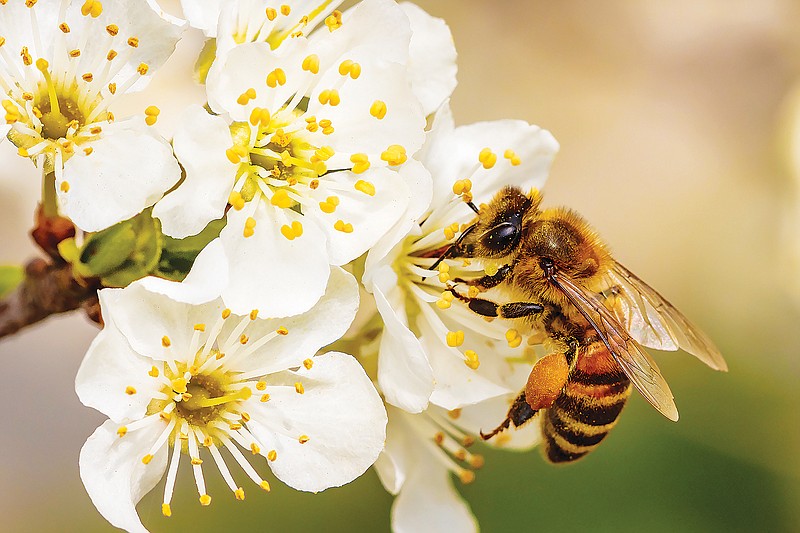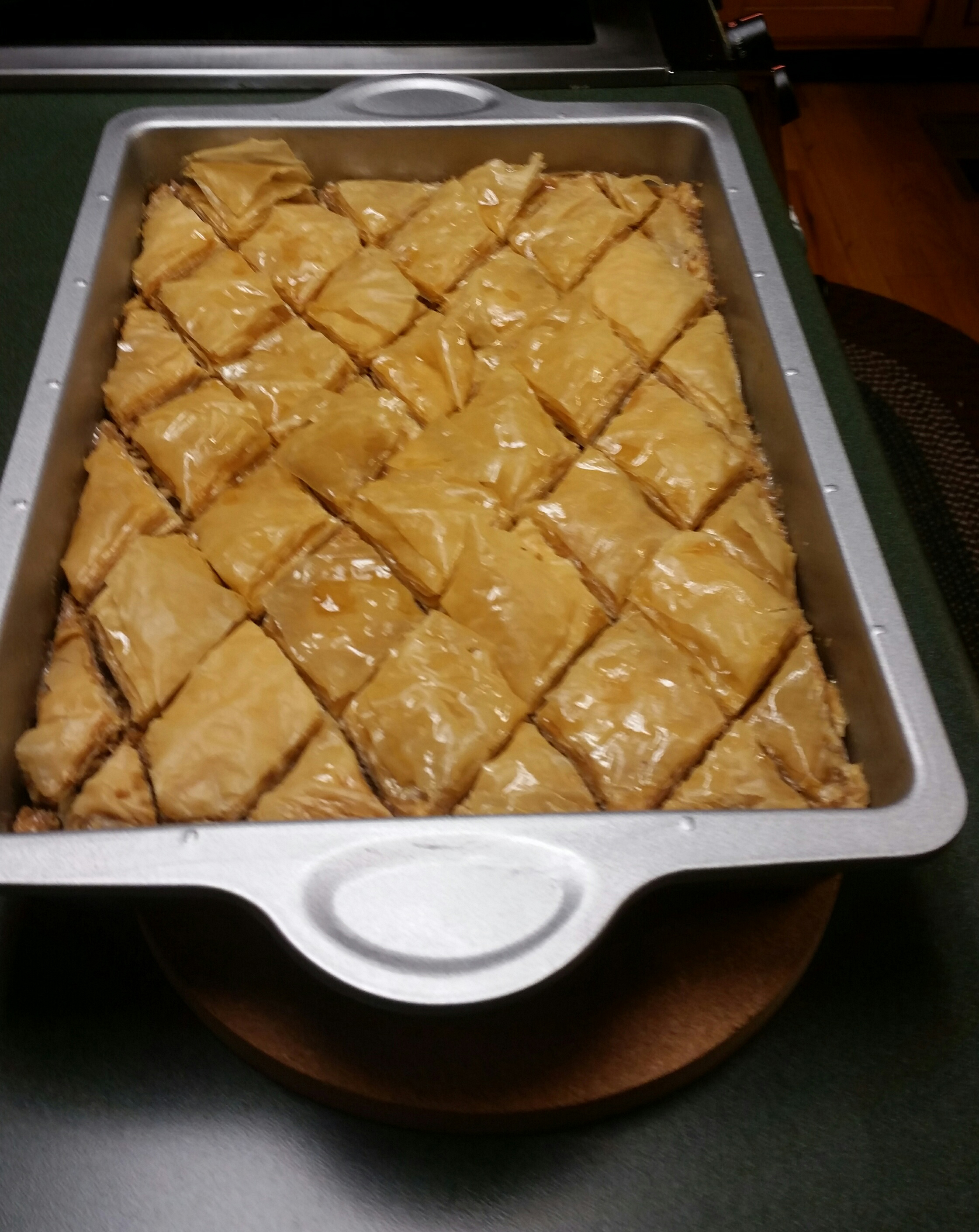Bees in the garden
Not ready to take up beekeeping but still want to help? Here are some tips from the Honeybee Conservancy.› Rethink your lawn. Replace part or all of your front lawn grass with flowering plants, which provide food and habitat for honey bees, bumble bees, solitary bees, butterflies and other pollinators.› Select single-flower tops for your bee garden. Choose daisies and marigolds, rather than double flower tops such as double impatiens. Double-headed flowers look showy but produce much less nectar and make it much more difficult for bees to access pollen.› Skip highly hybridized plants. They have been bred not to seed and thus produce very little pollen for bees.› Plan for blooms season-round. Plant at least three types of flowers in your bee garden to ensure blooms through as many seasons as possible. This will provide bees and other pollinators with a constant source of food.For example: Spring: Crocus, hyacinth, borage, calendula and wild lilac. Summer: Bee balm, cosmos, echinacea, snapdragons foxglove and hosta. Fall: Zinnias, sedum, asters, witch hazel and goldenrod.› Build homes for native bees. Leave a patch of the garden in a sunny spot uncultivated for native bees that burrow. Some native bees also need access to soil surface for nesting. For wood- and stem-nesting bees, this means piles of branches, bamboo sections, hollow reeds or nesting blocks made out of untreated wood. Mason bees need a source of water and mud, and many kinds of bees are attracted to weedy, untended hedgerows.› Use only natural pesticides and fertilizers. Not only are herbicides and chemical pesticides toxic to bees, but they also are best not introduced to children or adults who visit your garden. Ladybugs, spiders and praying mantises will naturally keep pest populations in check.› Create a “bee bath.” Bees need a place to get fresh, clean water. Fill a shallow container of water with pebbles or twigs for the bees to land on while drinking. Make sure to maintain the container full of fresh water to ensure that they know they can return to the same spot every day in your bee garden.› No room for a garden? You need only a small plot of land — it can even be a window container or rooftop — to create an inviting oasis for bees. Every little bit can help to nurture bees and other pollinators.Source: https://thehoneybeeconservancy.org
Put this on your honey-do list.
On Thursday, the Tennessee Valley Beekeepers Association will be at Whole Foods with a demonstration hive.
That's a Plexiglas enclosure with live bees on a comb, explains Brian Hamilton. He's media director for the TVBA, so he knows all the buzz.
If you go
Tennessee Valley Beekeepers Association will be the beneficiary of 5 Percent Day, receiving 5 percent of all profits, Thursday, April 19, at Whole Foods, 301 Manufacturers Road. Store hours are 7:30 a.m.-9 p.m. TVBA members will be on-site to answer questions and offer a demonstration with live (contained) bees. For more information, visit http://tennvalleybeekeepers.org.
Resources
› Tennessee Valley Beekeepers Association meets 7-8:30 p.m. fourth Mondays (January-November) at Red Bank Presbyterian Church, 4320 Dayton Blvd. (park in the back and use the back side entrance). http:tennvalleybeekeepers.org.› Ocoee Region Beekeepers Association meets 7-8:30 p.m. on third Tuesdays (January-October) at the Benton Municipal Building, 6496 Highway 411, Benton, Tenn. Tonight’s meeting will feature guest speaker Chris Kinser discussing “The Value of Wax and Drawn Comb/Hive Splits.” The group is on Facebook, or call 423-338-2792.› Cherokee Beekeepers Association meets at 7 p.m. fourth Tuesdays at AgCentral Farmers Co-op in Athens, Tenn. http://cherokeebeekeepers.blogspot.com.› Monroe County Beekeepers meets at 6:30 p.m. second Tuesdays at Hiwassee College, 225 Hiwassee College Drive, Madisonville, Tenn. 423-295-4858.› Elk Valley Beekeepers meets second Mondays of each month in Winchester, Tenn. 931-467-3868.Source: www.tnbeekeepers.org/bee-clubs
Beekeepers will answer any questions shoppers have about bees and beekeeping, and 5 percent of purchases made that day will go to the association.
"It will be by far the most significant fundraiser in the history of the TVBA," Hamilton says.
These 5 Percent Days are held quarterly in each store, part of the company's Store Level Giving Program, aimed at helping nonprofits that have "limited budgets and big hearts," according to the Whole Foods Markets website.
The company's focus, says the site, is to support innovative groups that strive to make the world a better place, one where "the environment is preserved and replenished, communities are strong, health is a priority, organic farming is cherished and where all living beings are respected."
Chloe George, store support associate team leader for the Chattanooga location, says the final decision among the applications received each quarter is made by store associates.
"We put out information on each organization and let [employees] vote," she says. "Everyone who works here gets to have input on who we choose."
At the end of the day, 5 percent of sales is calculated as a donation for the designated organization. The more people who shop, the greater the donation.
Hamilton says the beekeepers will use proceeds for their mentorship program, which trains new beekeepers.
Generally, 15 students take part in the program, one for each of the 15 state-registered hives on-site at the UT Extension Office on Bonny Oaks Drive, Hamilton says. Newbies, starting with no knowledge and no equipment, are paired with experienced beekeepers over several months to learn the basics. Participants meet evenings or Saturdays for hands-on training and lectures.
Hamilton says longtime members will bring that same expertise to Whole Foods for 5 Percent Day. They can readily answer questions about their own hives or bequeath more general knowledge about queen bees, the queens' pollen-seeking drones and how the flora the worker bees find contributes to the taste of the honey they produce. They'll also explain how crucial bees are to the food supply and the critical problem of colony collapse disorder, a phenomenon in which the majority of worker bees in a colony disappear.
First reported in 2006, colony collapse disorder has put scientists and backyard beekeepers on alert for understanding the multiple stressors that can lead to colony loss. The number of colonies lost to CCD has been declining since 2008, according to the National Pesticide Information Center, but the overall colony loss rate is still a major concern.
Ken Lee, a retired banker from Dunlap, Tenn., who has been beekeeping about five years, says there are multiple contributing factors.
"Right now, one of the biggest things we're dealing with is the loss of habitat for bees," he says.
There are also natural pests, such as Varroa mites and small hive beetles, plus "pesticides and chemicals are always a problem."
There's no simple answer for protecting bees, he says. "It's kind of a combination of all those things."
The beekeepers won't have samples of their honey, but George says Whole Foods carries a dozen brands, and each brand has multiple flavors.
If nothing else, the TVBA members are simply happy to talk on the bees' behalf to shoppers Thursday, Hamilton says. But if the event can beget new hobbyists, that would be sweet.
Contact Lisa Denton at ldenton@timesfreepress.com or 423-757-6281.
Baklava recipe
Blaine Reese says his fellow beekeepers bestow much praise on this recipe for baklava he makes for the Tennessee Valley Beekeepers Association’s annual picnic. He says he tried several recipes looking for a favorite, then customized this from the ones he liked best.Blaine’s BaklavaItems you will need:Two 1 1/2-quart bowls (one with cover)Nut/food chopper9- by 13- by 2-inch baking panPastry brush (I use a dedicated 2-inch polyester paint brush for speed and convenience)Straight edge (I find a clean 23-inch paint guide to be great)Sharp knife (I like a serrated tomato knife)Wax paperBase:1 pound frozen phyllo sheets (40 sheets in package) Athens Phyllo Sheets1 pound finely chopped walnuts (I use a KitchenAid manual chopper for about 50 strokes)1 cup sugar1 1/2 teaspoons ground cinnamon1 1/2 cups melted butterSyrup:3/4 cup sugar3/4 cup water1 cup honey1 1/2 tablespoons lemon juiceFor base: Thaw phyllo pastry according to package directions, and refrigerate until you start to assemble dry ingredients. Combine chopped walnuts, sugar and cinnamon in one 1 1/2-quart bowl, level top of mixture, and mark in 1/3 portions with spoon. Melt butter in microwave in covered 1 1/2-quart bowl. Open one package of pastry sheets, and roll out on provided wax paper. Have another piece of wax paper ready to cover unused sheets.Brush melted butter onto bottom and about ½ inch of sides of pan. Place one pastry sheet on bottom of pan (there will be a little excess length). Quickly brush the pastry sheet with melted butter, working from the center to the edges to remove any air bubbles under the pastry. Continue to add sheets and butter until 10 sheets are in pan. Cover the unused pastry sheets. Using the serrated knife, trim off the excess length of pastry and spoon 1/3 of the dry base ingredients onto the pastry.Repeat the above with 10 pastry sheets followed by 1/3 of the dry ingredients two more times, then top with remaining 10 pastry sheets, applying butter to each sheet.Trim the excess pastry length one more time. Using the straight edge and serrated knife, slightly score both diagonals of the top surface of pastry sheets. Continue to score pastry in lines parallel to the diagonals to produce a diamond pattern of the size you desire (I usually score the parallel lines about 1 1/4 inch apart).Using the sharp serrated knife, use the established diamond pattern to continue scoring the baklava to about 1/2 the depth of the pan. Bake in preheated oven at 300 degrees for 2 1/2 hours.For syrup: About 30 minutes before the baking is complete, place the water and sugar in a saucepan. Heat at medium/low setting until sugar is completely dissolved. Add lemon juice and honey to sugar syrup, and heat to consistency of water while stirring intermittently. Do not boil. Immediately after removing baklava from oven, pour the syrup evenly over the entire surface. Cool on rack at room temperature, then cover tightly and refrigerate at least overnight.Final steps: Uncover the refrigerated baklava, and follow the previous 1/2-depth scoring lines to slice the baklava to the bottom of the pan. It is OK to re-cover and refrigerate longer or to proceed to packaging.Depending on the size diamond pattern you have chosen, there will be 25 to 30 servings. I use cupcake liners to store and serve individual portions. I separate the liners and place them all on the countertop adjacent to the pan of baklava. I then remove several of the 1/4 and 1/2 diamond pieces with a thin flexible knife to access the full diamond pieces by sliding the knife underneath and lifting. Continue to remove the full diamond shapes, and place each in its cupcake liner. The remaining 1/4 and 1/2 diamond shapes are then combined into diamonds and placed in liners. While not as pleasing in appearance, these little pieces taste just like the full diamonds and should not be discarded.Stack the packaged diamond-shape portions loosely in Tupperware or other container, separating each layer of servings with sheet of wax paper. Cover with additional sheet of wax paper and apply airtight lid. Refrigerate until almost time to serve.— Recipe from Blaine Reese

